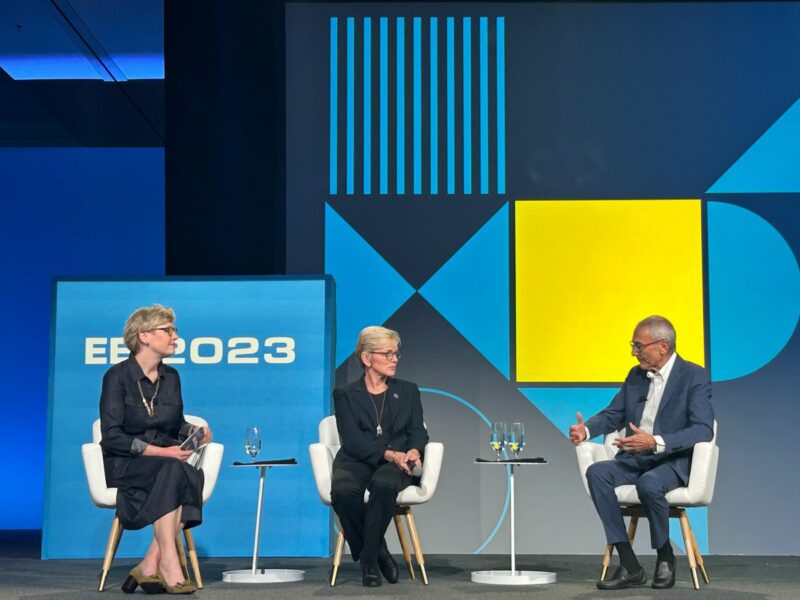Energy officials tout billions in tax credits available for companies, consumers for clean energy transition

Federal energy officials on Monday urged companies and consumers to take advantage of billions of dollars in federal funding to help the United States meet ambitious clean energy goals.
U.S. Energy Secretary Jennifer Granholm and John Podesta, Senior Advisor to President Joe Biden on Clean Energy Innovation and Implementation, said the energy industry needs to take advantage of the opportunities presented by the recently enacted Bipartisan Infrastructure Law (BIL) and the Inflation Reduction Act (IRA). The officials spoke during the Edison Electric Institute’s EEI 2023 event in Austin, in a conversation moderated by Maria Pope, president and CEO of Portland General Electric and EEI Vice Chair.
Podesta said the power industry was critical to building a cleaner energy system.
“In order to stabilize the atmosphere and create a livable planet … we need a transformation of the global economy on a size and scale that’s never occurred,” he said. “This industry is the point of the spear on making that reality happen.”
Granholm said that not only will the United States be a center for green energy innovation, but that federal legislation has made billions available to help companies embrace clean energy. She estimated that $23 trillion will be invested in clean energy by 2030 and that the U.S. will be at the center of that investment.
“We think we know now that because of the most progressive concessions in the world, that the United States has become an irresistible nation for investing in energy manufacturing,” she said.
Granholm said companies can apply for nearly $20 billion in federal funding, from programs like the Grid Resilience and Innovation Program, the Transmission Facilitation program, and others.
And the time to begin deploying new assets is now.
“I will say there’s one thing that you can do to help: in addition to applying is to deploy,” she said. “The notion of having to add 2,000 megawatts to the grid to be able to get to the goal of 100 percent clean electricity by 2035, that is going to require … a massive buildout of the capacity of the grid.”
Recent negotiations on the debt limit bill have helped to ensure those funds will continue to be available, Podesta said.
“We preserved that 10-year certainty that companies need in order to plan and make these big plays,” Podesta said. “We’re not going to create a cycle of innovation, a cycle of investment, unless people know what they can count on, and we’re there to protect that.”
Granholm said tax credits can add up to substantial savings for companies investing in clean energy. Through parts of the BIL that aim to reduce structural inequalities and inequities, companies can get tax credits for developing clean energy solutions in disadvantaged communities.
“That is incentivizing the repairing of some of the damage to communities that have been marked by the legacy of fossil fuels and the inequality that has run through the country,” she said.
To encourage consumers to use less energy and to incorporate energy efficiency into their lives, the federal government has launched https://www.energy.gov/save to provide consumers with information on what tax credits they are eligible for and how they can take control of energy costs by making energy efficient choices.
In addition, Pope announced EEI’s new website dedicated to helping its member electric companies educate their customers on how to find energy savings through Home Energy Rebate Program offerings, tax credits for electric vehicles, and other incentive programs that are part of the IRA.
Podesta said the IRA will create 9 million jobs over the next decade, and that provisions of the law will help with workforce development. The administration recently announced the creation of worker training hubs in five cities across the country to serve as examples for the rest of the country on how to engage in localization of workforce in connection with local community colleges and high schools, he said.
The energy leaders praised the partnership between the federal government and electric companies in advancing clean energy initiatives and working to inform consumers about the range of benefits available to them from the federal legislation.
“Meeting ambitious climate goals is going to take all of us. The goals are set by our customers and our communities, and will make a difference across our climate,” Pope said.
Granholm wrapped up the discussion by emphasizing this is a pivotal moment for the power sector. “I guarantee that we are in the middle of this incredible moment in history, that you’ll look back on and say, I was in that business when we made these incredible strides and set the table for us to reach these big, audacious goals of 100 percent clean electricity by 2035 and net zero by 2050,” she said.
